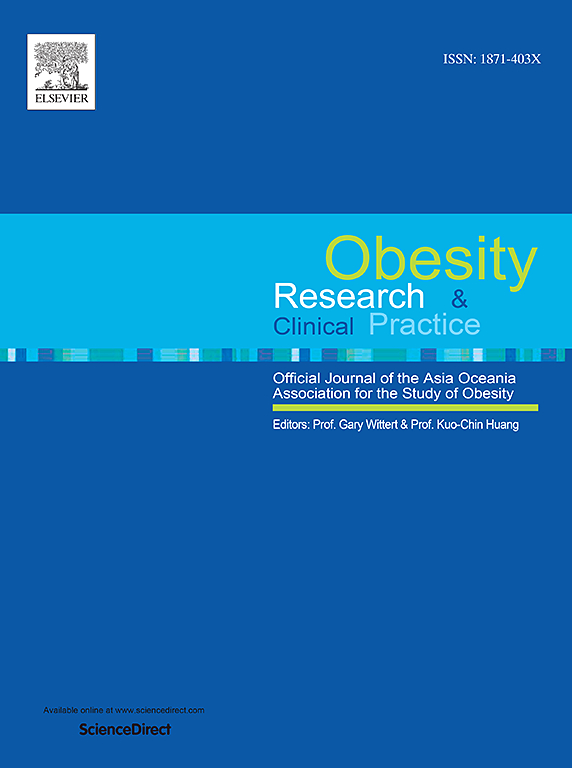Perceived self-efficacy and body mass index to identify older adults with and without fall history
IF 2.5
4区 医学
Q3 ENDOCRINOLOGY & METABOLISM
引用次数: 0
Abstract
Objective
The study aimed to analyze the relationship between a combined set of variables of several domains to identify older adults with and without a fall history. It was also aimed to identify the contribution of the variables included in the model.
Methods
This cross-sectional study was conducted with 191 older adults who performed the Timed-up-and-go Test (TUG), an imaginary TUG (iTUG), and were assessed for physical characteristics. The difference between the actual and imagined performances was calculated to represent perceived self-efficacy (TUGdiff). A decision tree model was applied to indicate the relevant variables to identify fallers and non-fallers, and a logistic regression was also used to determine the contribution of such variables.
Results
The decision tree identified body mass index (BMI) and TUGdiff as related to fall risk, with an accuracy of 71.4 %. Individuals with a BMI < 26.4 kg.m−2 were identified as non-fallers, while those with a BMI > 26.4 kg.m−2 and a TUGdiff lower than 3.89 s were also identified as non-fallers. The sensitivity of 0.91 and specificity of 0.26 showed good model accuracy in identifying non-fallers. The regression included BMI and TUGdiff as the main explanatory factors, while age, sex, cognition, TUG, and iTUG were not included as covariates because they did not reach the relative importance threshold of 15% in the decision tree analysis.
Conclusion
Older adults with decreased BMI were less prone to experience a fall. Older adults with increased BMI may experience a protective benefit of more accurate self-efficacy and become less prone to falls.
感知自我效能和身体质量指数来识别有和没有跌倒史的老年人。
目的:该研究旨在分析几个领域的组合变量集之间的关系,以确定有和没有跌倒史的老年人。它还旨在确定模型中包含的变量的贡献。方法:对191名老年人进行了横断面研究,他们进行了时间-起身-走测试(TUG),一个想象的TUG (iTUG),并评估了身体特征。计算实际表现和想象表现之间的差异来表示感知自我效能感(TUGdiff)。采用决策树模型来指示相关变量以识别降降者和非降降者,并使用逻辑回归来确定这些变量的贡献。结果:决策树识别出身体质量指数(BMI)和TUGdiff与跌倒风险相关,准确率为71.4 %。BMI为 -2的人被认为是不减肥的,而BMI为 > 26.4 kg的人被认为是不减肥的。m-2和TUGdiff小于3.89 s也被确定为非降落者。敏感性为0.91,特异度为0.26,表明模型在识别非降压者方面具有良好的准确性。回归将BMI和TUGdiff作为主要解释因素,而年龄、性别、认知、TUG和iTUG由于在决策树分析中未达到15%的相对重要阈值而未被纳入协变量。结论:BMI指数降低的老年人更不容易跌倒。体重指数增加的老年人可能会体验到更准确的自我效能感带来的保护效益,并且不太容易摔倒。
本文章由计算机程序翻译,如有差异,请以英文原文为准。
求助全文
约1分钟内获得全文
求助全文
来源期刊

Obesity research & clinical practice
医学-内分泌学与代谢
CiteScore
7.10
自引率
0.00%
发文量
80
审稿时长
49 days
期刊介绍:
The aim of Obesity Research & Clinical Practice (ORCP) is to publish high quality clinical and basic research relating to the epidemiology, mechanism, complications and treatment of obesity and the complication of obesity. Studies relating to the Asia Oceania region are particularly welcome, given the increasing burden of obesity in Asia Pacific, compounded by specific regional population-based and genetic issues, and the devastating personal and economic consequences. The journal aims to expose health care practitioners, clinical researchers, basic scientists, epidemiologists, and public health officials in the region to all areas of obesity research and practice. In addition to original research the ORCP publishes reviews, patient reports, short communications, and letters to the editor (including comments on published papers). The proceedings and abstracts of the Annual Meeting of the Asia Oceania Association for the Study of Obesity is published as a supplement each year.
 求助内容:
求助内容: 应助结果提醒方式:
应助结果提醒方式:


